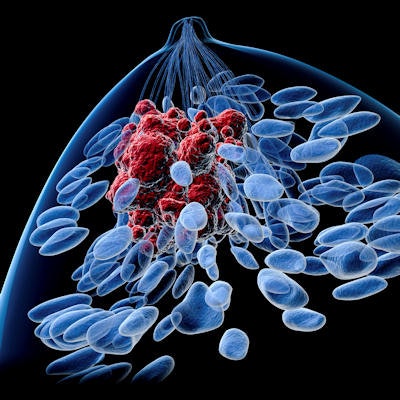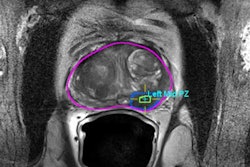
Elastography can help determine treatment response in patients with locally advanced breast cancer during the course of neoadjuvant chemotherapy, according to a study published in July in BJR.
The study results suggest the technique can assist clinicians in managing treatment for patients with breast cancer, wrote a team led by Dr. Amit Katyan of Vardhman Mahavir Medical College and Safdarjung Hospital in New Delhi.
"Strain ratio is the earliest predictor of treatment response in patients [with locally advanced breast cancer]," the group wrote. "Serial imaging with elastography has the potential to predict treatment response early during the course of [neoadjuvant chemotherapy], which may prove vital in management of patients with breast cancer."
Locally advanced breast cancer is associated with a poor prognosis because of high rates of locoregional recurrence and distant metastasis, according to Katyan and colleagues.
The current standard of care is chemotherapy followed by mastectomy and removal of axillary nodes. Chemotherapy shrinks the tumor in an effort to improve surgical outcomes, but assessing its effectiveness is limited to conventional imaging methods such as mammography or B-mode ultrasound to monitor changes in tumor size. In contrast, elastography can track chemotherapy-induced changes in the molecular, vascular, and biomechanical properties of the tumor, which can be identified before the tumor tissue changes, the group wrote.
To further investigate elastography's effectiveness for this application, Katyan's group conducted a study that included 86 patients with locally advanced breast cancer who underwent strain wave elastography. The patients had an elastography exam before each cycle of chemotherapy and before surgery. The researchers evaluated changes in elastographic parameters such as size ratio and strain ratio and compared them with clinical and pathologic tumor response after mastectomy (BJR, July 2019, Vol. 92:1099, 20180515).
Strain ratio parameters on elastography showed high sensitivity and moderate specificity for determining response -- even after the first cycle of chemotherapy, the group found. In addition, size ratio parameters demonstrated moderate sensitivity and specificity for response after the women's second and third cycle of chemotherapy.
| Elastography strain and size ratios as predictors of chemotherapy response in women with breast cancer | ||
| Performance measure | Strain ratio parameters on elastography | Size ratio parameters on elastography |
| Sensitivity | ||
| After 1st chemotherapy cycle | 97.7% | 38.9% |
| After 2nd chemotherapy cycle | 100% | 83.3% |
| After 3rd chemotherapy cycle | 100% | 77.8% |
| Specificity | ||
| After 1st chemotherapy cycle | 68.7% | 80% |
| After 2nd chemotherapy cycle | 89.7% | 80% |
| After 3rd chemotherapy cycle | 94.9% | 100% |
The results demonstrate that strain wave elastography is an effective modality for assessing each cycle of chemotherapy in women with locally advanced breast cancer, Katyan and colleagues wrote.
"Strain wave elastography is a powerful tool to predict chemoresponse early during the course of management, thereby providing an optimal window to change treatment protocols," the group concluded.



















